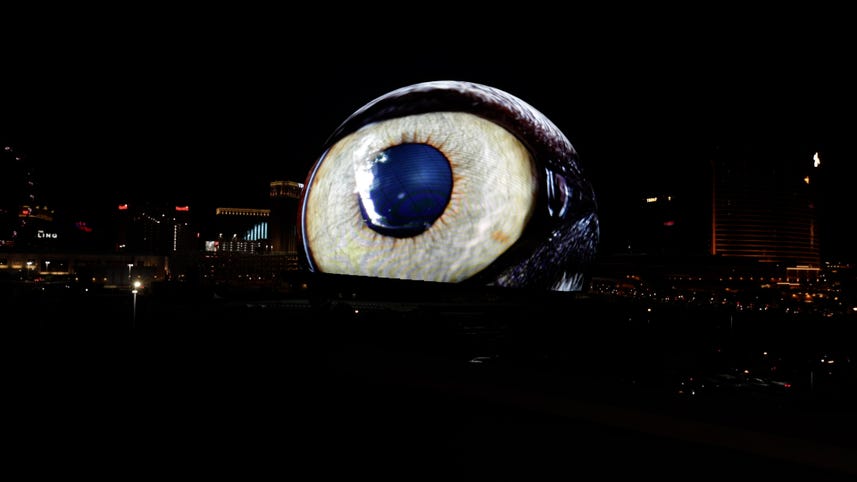
Speaker 1: Up here at Big Dome Studios in Burbank, where they test out all the new technology for that $2.3 billion sphere in Las Vegas. Unfortunately, they won't let me film inside, but I'm gonna do my best to explain to you all the different demos we're gonna get today. Let's check it out. You've probably seen clips or videos of the massive sphere going around on social media. We talked to M S G Ventures, c e o, David Dibel to get the lowdown on the technology. Powering this first of its kind venue. Speaker 2: We like to think that we're creating experiences that is VR life, but you don't need the goggle. Speaker 1: [00:00:30] This monumental effort has required the development of brand new technologies, including audio, video, and camera systems, several of which I got to experience during my visit to Big Dome. I'll leave timestamps down below if you'd like to skip around. Now let's get started with our first demo. How the heck do you create immersive audio inside a sphere? Speaker 2: It's a curved structure and 3 million cubic feet in volume. Curved performance poles are phenomenal for viewing. It's a nightmare for audio. Speaker 1: [00:01:00] They partnered with Hollow Plot, a Berlin based tech company, breaking new ground in wavefield synthesis and beam forming audio for use inside the echoy setting of subways. Basically, this technology allows sound to be projected more precisely through space to the point that people sitting in different sections can hear different languages, different instruments, or different audio elements. For example, in one of the demos I heard they applied this to languages. Depending on where I stood, I could hear the audio in English, Chinese, [00:01:30] or Arabic. I also heard it applied to music with different areas in space, highlighting different instruments. I also heard a demo that made it sound as if an actor was walking towards me and speaking right into my ear. Speaker 2: We have about 164,000 individual drivers, uh, on that system, and they are all, uh, individually addressable. Each panel has a built-in microphone, so they listen to themselves and tune in real time. Speaker 1: This demo was only a small [00:02:00] fraction of what will be experienced inside the full size sphere, but it didn't stop there. Inside a mixing room where artists can prepare their audio for playback on the spheres system, I got to feel a gust of wind from something like an air cannon, which showed how the sphere system plans to create a sense of touch to go along with their audio system. There were also hints that things like humidity, temperature, and even smells could potentially be utilized for artistic effect as well. The next demo was of a one quarter scale screen. While sitting [00:02:30] down, we got a taste of the challenging acoustics engineers were battling inside the sphere as our voices bounced off the curved screen. I was told that inside the Las Vegas sphere, the LEDs that make up the full size screen are farther apart than the ones in the quarter scale model. Speaker 1: So sound travels through them rather than bouncing back at the audience. On that one quarter scale screen, we were treated to a diverse array of test clips filmed specifically to explore the possibilities of a screen of that size and shape. I'll be using clips from Getty [00:03:00] to give a sense of what I saw, but just to be clear, these are not the actual clips. The first clip was a camera traveling slowly through a forest. Then I saw tests of various camera moves, an underwater scene, and perhaps most memorably a roller coaster That felt uncannily real. One thing that struck me about the viewing experience is how immersive it was. I could tilt my head all the way up and still not see the edge of the screen. Speaker 2: The learnings in vr, the virtual reality world, apply directly [00:03:30] to what we're trying to do here. 'cause we like to think that we're creating experiences that is vr like, but you don't need the goggle. Speaker 1: Some of these images that I saw were captured by multiple cameras put together in an array and then stitched together after the fact in post-production, while other videos were captured with a brand new camera developed by the M S G sphere team, specifically for the Sphere's unique aspect ratio, which is far larger than imax, the camera called Big Sky has a whopping 16 K resolution. Speaker 2: [00:04:00] Matter of fact, the big Sky system is going up into the International Space Station next year, uh, and it's going on, uh, an e v a extra vehicular activity, spacewalk to, uh, photograph the heavens and back on our own blue planet. Speaker 1: Altogether, the countless engineering challenges resulted in the budget ballooning from a predicted 1.2 billion in 2018 to $2.3 billion. Speaker 2: We didn't know what this medium was gonna present to us. It was testing, test, learn, test, learn, test, learn. Speaker 1: The sphere [00:04:30] is opening this September with a performance by U two, followed shortly after by a special film presentation from Darren Aronofsky called Postcard from Earth. Tickets on the Sphere website are shown to cost between 49 and $199. As always, thanks so much for watching. I'm your host, Jesse Oral. See you next time with the fam.
First Look at the Tech Inside the $2.3B MSG Sphere - Video - CNET
Read More
Bagikan Berita Ini

















0 Response to "First Look at the Tech Inside the $2.3B MSG Sphere - Video - CNET"
Post a Comment